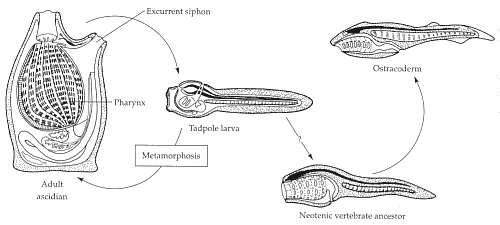
The Garstang Hypothesis

Modern Ascidians
(Subphylum Urochordata)
typically have a motile tadpole larva that undergoes
metamorphosis to a
sessile adult [left]. The tadpole has the typical
characteristics of Chordata,
including a notochord, pharyngeal gill slits,
and a post-anal
tail.
According to the
Garstang Hypothesis
(propounded by William
Garstang (1868 - 1949)), development
of
sexual maturity in a non-metamorphosing lineage of
tunicates
might provide the immediate proto-chordate ancestors of more
typical
chordates
such as Amphioxus (Subphylum Cephalochordata),
or
even
of
early Vertebrata (Ostracoderms) as shown here.
Development
of sexual maturity in a larval form is an example of Progenesis
(Garstang called the process Neoteny, which today is
used for a
different but related differential growth phenomenon).